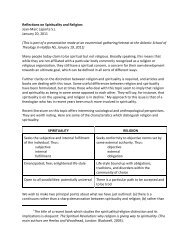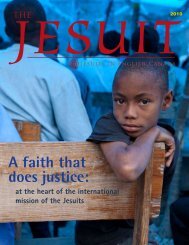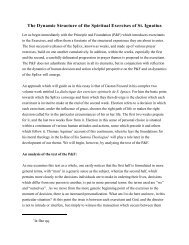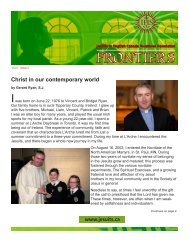Understanding the spiritual journey: from the classical tradition to the ...
Understanding the spiritual journey: from the classical tradition to the ...
Understanding the spiritual journey: from the classical tradition to the ...
You also want an ePaper? Increase the reach of your titles
YUMPU automatically turns print PDFs into web optimized ePapers that Google loves.
oblivious of all else; in <strong>the</strong> fourth my love for God leads me <strong>to</strong> love o<strong>the</strong>rs as God loves <strong>the</strong>m,and I become involved in <strong>the</strong> world in a completely different way.2.2 Richard within <strong>the</strong> <strong>tradition</strong>: a broader perspective: We have described <strong>the</strong> specificcontribution made by Richard’s four degrees of violent love, and now we will place hiscontribution in a broader perspective.2.2.1 First of all, we note that <strong>the</strong> four degrees of violent love are not Richard’s onlycontribution <strong>to</strong> <strong>the</strong> <strong>tradition</strong>. These four degrees pertain <strong>to</strong> <strong>the</strong> <strong>spiritual</strong> life as a whole, but histwo works on contemplation, The Twelve Patriarchs and The Mystical Ark, offer clarity on howone prepares for and progresses in contemplation. An earlier work, The Edict of Alexander,adheres <strong>to</strong> <strong>the</strong> <strong>classical</strong> three stages, but hints at <strong>the</strong> fourth stage which emerges in The FourDegrees of Violent Love. 17 It also offers a key, as we shall see in <strong>the</strong> next section, <strong>to</strong> understandhow we can superimpose <strong>the</strong> three <strong>classical</strong> ways on <strong>the</strong> four Ignatian weeks.Finally in his On <strong>the</strong> Extermination of Evil and <strong>the</strong> Promotion of Good, a treatise not yettranslated in<strong>to</strong> English, he offers a very useful image which helps us link <strong>the</strong> <strong>classical</strong> <strong>tradition</strong>with <strong>the</strong> Pauline movement <strong>from</strong> justification through sanctification <strong>to</strong> salvation. The key textis Ps 114:5: “Why is it, O sea, that you fled? O Jordan, that you turned back?” This text alludes<strong>to</strong> two miracles which begin and end <strong>the</strong> long <strong>journey</strong> of <strong>the</strong> chosen people <strong>from</strong> being slavesin Egypt <strong>to</strong> enjoying <strong>the</strong> Promised Land. Between <strong>the</strong>se events <strong>the</strong> chosen people make a long<strong>journey</strong> through <strong>the</strong> desert. Both of <strong>the</strong>se events are miracles having <strong>to</strong> do with water. In <strong>the</strong>irflight out of Egypt, <strong>the</strong> waters of <strong>the</strong> Red Sea parted so <strong>the</strong>y could leave behind <strong>the</strong>ir pursuersand carry on <strong>the</strong>ir <strong>journey</strong>. But at <strong>the</strong> end of <strong>the</strong>re <strong>journey</strong> <strong>the</strong> Jordan river s<strong>to</strong>pped its courseso that <strong>the</strong>y could get through <strong>to</strong> <strong>the</strong> promised land. The first event corresponds <strong>to</strong>justification in Pauline terms, <strong>the</strong> second <strong>to</strong> salvation, and what lies in between is <strong>the</strong> lengthy<strong>journey</strong> of sanctification which has its ups and downs, its meanderings and delays.2.2.2 There is a clear Pauline antecedent <strong>to</strong> Richard’s transition <strong>from</strong> absorption in<strong>to</strong> God(<strong>the</strong> third degree of violent love, which in <strong>the</strong> <strong>classical</strong> scheme would be <strong>the</strong> final one) <strong>to</strong>compassion for <strong>the</strong> world (<strong>the</strong> fourth degree). The key passage is Phil 1:23-24: “I desire <strong>to</strong> bedissolved and <strong>to</strong> be with Christ...But <strong>to</strong> remain in <strong>the</strong> flesh in more necessary for you”. Theliquefaction <strong>to</strong> which Richard alludes in his third degree is clearly evoked in this passage with<strong>the</strong> term “dissolved”. To be <strong>to</strong>tally absorbed in<strong>to</strong> Christ is Paul’s deepest desire, but evenstronger is his readiness <strong>to</strong> carry on his ministry in <strong>the</strong> earthly state as long as that is God’s willfor him. Ano<strong>the</strong>r text which indicates his readiness <strong>to</strong> depart <strong>from</strong> warm intimacy with God is17 Each of <strong>the</strong> three <strong>classical</strong> stages is differentiated in this early work. Purgation begins withfear, regret for past sins committed, but <strong>the</strong>n leads <strong>to</strong> an active, loving life of good works <strong>to</strong> make upfor <strong>the</strong> good one has not done in <strong>the</strong> past. Sanctification begins with increase in perfection, but suchincrease needs <strong>to</strong> be accompanied by perseverance if it is <strong>to</strong> be ultimately fruitful. Union begins with amore imperfect contemplation through sensible things; continues with a more perfect contemplationwhich allows <strong>the</strong> genuinely contemplative a glimpse of God without such mediation; and beyond thatsome are called <strong>to</strong> be prophets, <strong>to</strong> share with o<strong>the</strong>rs <strong>the</strong> knowledge <strong>the</strong>y have received incontemplation.










